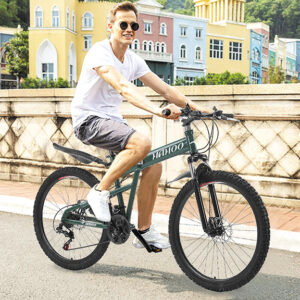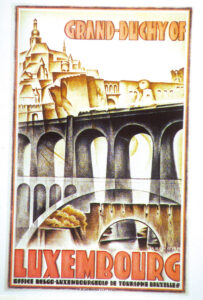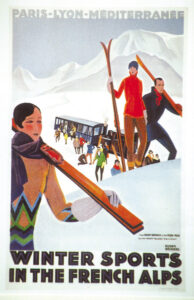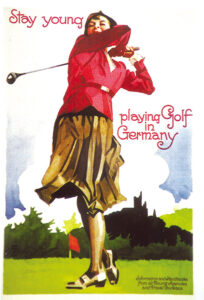 By Robert Reed
By Robert Reed Collectors today can take that dreamed-of trip, or they can seek out a treasured travel poster of the past. Either way they are sure to have something to long remember.
From air travel to railways, and from bicycles to ocean liners, travel posters have lured people to find some means to roam distant locations.
Generally, for all their appeal, travel posters were not designed to last beyond a single season. Those that did survive are prized currently from the major auction houses to antique malls in the crossroads of America. “Travel and transportation posters are a major postercollecting field with global impact and numerous specializations,” noted Tony Fuscho author of the distinguished volume Posters, second edition.
Besides all the obvious methods of transportation on travel posters, there are also those which featured the resorts themselves and what Fuscho calls “sporting vacations” at particular locations.
Some of the earliest travel posters in America were those which appealed to the public in the 1860s and 1870s to ride the newly completed railroads across the United States. In 1869 posters from the Union Pacific Railroad boasted “Pullman’s palace sleeping cars” and welcomed “travelers for pleasure, health, or business” who would ride all the way to San Francisco. In 1870 the Central and Union Pacific Railroads promised travel from San Francisco to New York in only six days and 20 hours.
 Bicycles were a major attraction by the 1890s, and Paris was the leading location for their manufacture and luxury use. To meet the fierce competition bicycle makers commissioned leading French artists such as Henri Thiriet, Jules Cheret, and Eugene Grasset to provide stunning posters.
Bicycles were a major attraction by the 1890s, and Paris was the leading location for their manufacture and luxury use. To meet the fierce competition bicycle makers commissioned leading French artists such as Henri Thiriet, Jules Cheret, and Eugene Grasset to provide stunning posters. That fashionable bicycle could come from an array of French producers including Dayton, DuBois, Clement, Omnium, Pefecta, Solieil, Stella, Peugeot, and Liberator. American and British makers who offered similar poster campaigns included Columbia, Raleigh, Stearns, and Victor.
But bicycles were certainly not the only source of travel posters in the 1890s. As the world grew smaller there was a growing awareness of a developing middle class in both Europe and American. Before only the very wealthy could afford to travel, but now a ‘new’ emerging class of travelers appeared.
Increasingly both railroads and ocean liners also turned to travel posters to attract the tourists.
State-operated railroads in European countries like France and England during that period used the graphic print method to attract foreign visitors. They stressed the concept of “leisure” travel and encouraged the idea of cultural development. As Fusco points out, often the posters did not feature the actual trains but instead depicted the scenery of places along the way.
Red Star Lines boasted of wonderful trips from New York and Philadelphia to Belgium in the late 19th century. Gunard Lines meanwhile bragged that even third-class passengers could go by ship across the Atlantic from England to the United States in only five days, seven hours and 23 minutes. It was billed as “record passage by the old reliable.”
 Ocean liners continued to dominate both the travel business and the use of travel posters early in the 20th century. French Lines chose to highlight the word “France” in many of their 1900s posters. American Lines used posters to offer direct ocean transport service from Southhampton to New York. By 1913 Cunard Lines full-color posters proclaimed travel “to all parts of the world.”
Ocean liners continued to dominate both the travel business and the use of travel posters early in the 20th century. French Lines chose to highlight the word “France” in many of their 1900s posters. American Lines used posters to offer direct ocean transport service from Southhampton to New York. By 1913 Cunard Lines full-color posters proclaimed travel “to all parts of the world.” Worldwide trips were offered on travel posters of early 1920s by the London-based Orient Line Cruises. One example depicted stylish people swimming in a pool on board a luxury ship. For those with a little less time other posters offered trips by ferry boat from France to England.
Back in the United States during the Roaring Twenties automobile traffic was already a problem. Travel posters announced Chicago’s unique solution to the problem. “Avoid street congestion,” exclaimed a poster in behalf of Rapid Transit Lines. It featured the city’s El tracks with crowded traffic in the background.
In the middle l920s still another railway added a series of travel posters which incorporated travel with a sports event. The South Shore Line offered to take fans to the Notre Dame football games from Chicago to South Bend, Indiana. This is one of many sports-related posters of that period. Winter Sports in the French Alps was a major topic, along with major golf resorts in France. By 1928 event major aviation events in various parts of the world became the subject of elaborate travel promotions.
Early in the 1930s major American cities when toeto-toe and even poster to poster in an attempt to entice travelers to their particular location. The Illinois Central Railroad advertised Chicago as “The Vacation City” in its colorful posters. And a series of Travel by Train posters sponsored in part by the American Railroad Companies of America offered Atlantic City as “the playground of the world.”
 Smaller tourist spots were in play as well as the metropolitan sites during that era. The Boston and Maine Railroad, for example, used posters to draw visitors to tiny Lake Winnipesaukee in New Hampshire. More ambitious railroad travelers could simply “See America” 1939 by journeying from the World’s Fair in New York City across the country to the Golden Gate International Exposition in San Francisco.
Smaller tourist spots were in play as well as the metropolitan sites during that era. The Boston and Maine Railroad, for example, used posters to draw visitors to tiny Lake Winnipesaukee in New Hampshire. More ambitious railroad travelers could simply “See America” 1939 by journeying from the World’s Fair in New York City across the country to the Golden Gate International Exposition in San Francisco. Following the war years of the early 1940s, still another travel element moved heavily to the marketplace and consequently into elaborate travel posters. The airlines clearly wanted to take travelers away from it all too. Major airline poster users of the late 1940s included Pan American Air Lines, Dutch KLM Airlines, Air France, and American Airlines. By the early l950s American Airlines had launched a series of travel posters promoting numerous flights including trips to Hawaii. American Airlines was one of the first airlines to go with a full series of posters, and to commission major artists for the job.
It was American which used artist E. McKight Kauffer to illustrate travel posters which featured locations both in the United States and Europe. Kauffer, an American born artist living in England, was one of the most talented and versatile contributors of his time. It was Kauffer who also created a dashing Kentucky Derby travel poster in behalf of Chesapeake and Ohio Railroads.
Mention of Kauffer leads to one of the more significant factors regarding travel posters, the artist.
Some very famous artists have contributed to this specific aspect of posters over the years including Edward Penfield, Alphonse Mucha, Frederick Lawler, A.M. Cassandre, Otto Baumberger, and Paul Colin. Even esteemed American artist Maxfield Parish rendered a few travel posters during the 1930s for the New Hampshire Planning and Development.
Important artists naturally contribute greatly to the value of many travel posters of the past.
However there are also other considerations.
Content and graphic appearance can also be very important. A catalog of travel posters prepared by Swann Galleries recently noted, “…in grading a poster’s condition the standards and criteria of the print collector cannot be used. The most important element in grading a poster’s condition is its appearance as defined by lines, colors and overall deign.”
Recommended reading: Posters by Tony Fusco, 2nd edition, Avon Books.















Follow Us